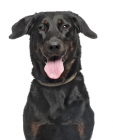Sussex Spaniel
In my own words
Hey! Are you busy? I was thinking maybe we could go out for a walk or something, wouldn’t that be fun? Maybe we’ll see some squirrels! I love chasing squirrels but they never play fair, I can’t climb up trees! My breed is a working dog but did you know we make really good therapy dogs. Isn’t that nice? I just like to chill out, you know, I don’t mind working but it’s nice to relax. I love curling up for a cuddle at the end of the day, don’t you? It’s the best part of the day, I think!
Are the children coming home from school soon? I like playing with them even though they do tug at my ears sometimes! I don’t mind really though, as long as I’m with my family I’m happy. Can we go out for a walk soon? I have my eye on some squirrels...
My ideal owner(s)
Retirees
City-dwellers
Outdoorsy types
Experienced dog handlers
Families
What they say about me
Playful
Energetic
Loyal
Intelligent
Please read on, to find out more about me, and whether I will be someone you can be happy with for the next 12 years, or even longer!
Is this Sussex Spaniel for you?
Test your knowledge about the Sussex Spaniel
Information essential about the Sussex Spaniel
Kennel Club Group:
Gun Dog
Size:
Medium: Weight 40 – 44 lb (18 – 20 kg)
Height 13 – 15” (38 – 41 cm)
Popularity:
Breed History:
The Sussex Spaniel originated in Sussex, England in the 1800s and is credited to Mr Augustus Elliott Fuller who kept them as working dogs on his large estate. Not particularly fast or boisterous, it was nevertheless a determined and loyal companion in the field. The Sussex Spaniel Association was formed in 1924. Despite there being other Sussex Spaniel breeders, the popularity of this breed declined dramatically by World War II resulting in only five known Sussex Spaniels remaining in 1945. Mrs Joy Freer then devoted her life to breeding the Sussex Spaniel and her dogs worked well in the field.
Today in the UK there is still a very small gene pool for this breed. The Sussex Spaniel was recognised by the Kennel Club in 2004 as a Vulnerable British Breed and at its lowest in 2010 only 52 puppies were registered.
Character:
Unlike most other Spaniels, the Sussex Spaniel prefers a slower pace of life even though it can be energetic. It is an excellent field dog and displays the natural ‘quartering’ ability shown by Cockers and Springers. Once trained they can be very obedient but can be a bit stubborn and decides when it wants to learn. This breed is playful, fun loving and happy with children which can be enhanced by early socialisation. This breed really likes people and is happy to curl up with its owner for a cuddle after a walk. Their sedate and relaxed behaviour makes them excellent PAT therapy dogs in hospitals, schools and hospices.
Temperament:
When the Sussex hits the open field, its hunting instincts take over and the energy level really picks up. It romps through forests, fields and streams, barking and baying at birds, squirrels and the like. The Sussex Spaniel is clever and loyal, but sometimes it can have a mind of its own. This breed has a cheerful disposition and can be wilful at times. They are not as quick to learn as some breeds so require patience with training and they are happy, loyal dogs to their owner. This breed is adaptable and laid back but require early socialisation when they are young.
Conformation:
The Sussex Spaniel is similar in shape to the Clumber Spaniel and is low, small and compact. The ears are typical of all Spaniels – long, pendent and set moderately low on the head. The eyes are usually a lighter brown or amber colour. This dog has profuse feathering on the belly, legs and tail. The Sussex Spaniel has a long, low, rectangular frame covered in a wavy, feathered coat that usually comes in a nice golden liver. Its broad, flat-topped, slightly indented head has a heavy brow, a wide muzzle, brown nose, hazel eyes and large, feathered ears that hang close. Its thick tail, sometimes docked, is normally carried horizontal or high. This breed is heavily built with short yet strong legs. The neck should be long, strong and slightly arched. They have a well developed deep chest that is not too wide or round. They should appear level and have no apparent waist from the withers to the hips. They move with a distinctive rolling gait.
The coat is silky, soft and can have a slight wave to it
Colour:
The preferred colour for the show ring is rich golden liver with the hair shading to golden at the tip. Dark liver is undesirable. They are a rich golden liver colour shading to gold at the hair tips.
Training:
While intelligent, the Sussex chooses when it want to learn, and so responds best to positive and reward based training methods. The trainer must also be capable of showing considerable patience and always finish a training session on a high note to reinforce the good work done. They make very good pets, but they need plenty of socialisation when young. It is important that they are introduced regularly to children, dogs, cars etc when young. This socialisation should be kept up until the dog is mature.
Care:
This breed requires frequent grooming, preferably every day and may also benefit from professional grooming ever 2-3 months. The hair under the feet and ears benefits from regularly being trimmed. The longer ears of this breed have a tendency to trap moisture and dirt underneath so it is important to check and clean the ears regularly.
Health:
The lifespan of a healthy individual is between 10 and 12 years, which is normal for a dog of this size. However, some live for as long as 15 years. If you buy from a reputable, responsible breeder, health problems should not occur. This breed is hardy and on average lives up to 15 years of age. They have relatively few genetic health issues but the most common problems in this breed are heart problems, ear infections, hypothyroidism and eye problems. They can also suffer from hip dysplasia.
Exercise:
Be careful not to over exercise this breed as a puppy. They require stimulation to prevent them becoming bored and can be very energetic but do not require excessive amounts of exercise.They do best in the country where they are free to run and roam.
You may also like:
If you like Sussex Spaniels, you may be interested in breeds of the same size »





If you like Sussex Spaniels, you may like other breeds with similar characteristics »





Advice on choosing your breed »
Find an animal shelter or rescue home where a Sussex Spaniel is waiting for a new home »
The following grid gives a fast track review which covers all breeds. You can apply it to help you decide if a Sussex Spaniel is suitable for you, the environment where you live, your personality and your lifestyle. On the grid, 1= strongly disagree, and 5= strongly agree. You might like to save or print off this section and keep it for reference while you check some other breeds before making your final choice.
Be the first to rate this breed »
|
*PLEASE NOTE: All our breed profiles are general, and all dogs are individuals. Always talk to the breeders and meet the owners you are buying from. Try to meet the dog and its parents if it is a puppy in their home environment.










